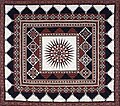English paper piecing: Difference between revisions
Added Quilt Information, provided information on supplies. Tags: Incorrectly formatted external link or image Visual edit |
rv promotionally-worded examples with placeholder images |
||
| Line 1: | Line 1: | ||
[[File:English_paper_piecing.jpg|thumb|Star shapes made by paper piecing]] |
[[File:English_paper_piecing.jpg|thumb|Star shapes made by paper piecing]] |
||
'''English |
'''English paper piecing''' (or '''paper piecing''') is a method of attaching and stabilizing pieces of fabric together, based on [[foundation piecing]].<ref>{{cite web|title=The History of Modern Foundation Piecing|url=http://www.quilterbydesign.com/lessons/paper_piecing_history.html|website=www.quilterbydesign.com}}</ref> The practice's name comes from the fact that it was, and still is, popular in Britain. The technique used to paper piece involves wrapping paper shapes in fabric and then stitching the fabric together. Once a shape, bloc, rosette, or finished piece has been made, the papers are removed, leaving the fabric as the remaining item. The technique has been dated back to January of 1889 and when the papers had been left on.{{huh?|date=January 2017}} |
||
[[Carol Doak]] was known{{by whom|date=January 2017}} for being one of the modern teachers at the 1992 [[Quilt Festival]], though not{{huh?|date=January 2017}} her now popular foundation piecing classes of today. Doak's book, ''Easy Machine Paper Piecing: 65 Quilt Blocks for Foundation Piecing'' has sold over 127,000 copies worldwide. She helped to coin the term "paper piecing" from the root of "paper foundation piecing".{{citation needed|date=January 2017}} |
[[Carol Doak]] was known{{by whom|date=January 2017}} for being one of the modern teachers at the 1992 [[Quilt Festival]], though not{{huh?|date=January 2017}} her now popular foundation piecing classes of today. Doak's book, ''Easy Machine Paper Piecing: 65 Quilt Blocks for Foundation Piecing'' has sold over 127,000 copies worldwide. She helped to coin the term "paper piecing" from the root of "paper foundation piecing".{{citation needed|date=January 2017}} |
||
== La Passacaglia Quilt == |
|||
[[File:Little_amsterdam.jpg|link=https://en.wikipedia.org/wiki/File:Little_amsterdam.jpg|thumb|A patchwork representing Little Amsterdam]] |
|||
One of the most well known quilts in the modern era is the La Passacaglia Quilt. [http://www.tulapink.com/ Tula Pink,] who is a famous fabric designer, is considered one of the key influences with making the La Passacaglia Quilt popular. Her rendition leverages her line of modern fabrics. What made Tula Pink's quilt unique was the fact that she enlarged the original shapes in order to maker her quilt shapes bigger. |
|||
==== Book ==== |
|||
The book can be purchased on the [http://www.quiltmania.com/ Quiltmania website]. |
|||
==== Paper Pieces and Acrilyc Templates ==== |
|||
You can find the paper pieces and acrylics templates for the quilt, for sale at [https://www.paperpieces.com/la-passacaglia-starter-piece-pack Paper Pieces]. |
|||
==== Tutorials ==== |
|||
Extensive video and written [https://thediyaddict.com/la-passacaglia/complete-how-to-guide La Passacaglia Quilt Tutorials] have been written by Karen Tripp. |
|||
== Dear Jane Quilt == |
|||
[[File:Little_amsterdam.jpg|link=https://en.wikipedia.org/wiki/File:Little_amsterdam.jpg|thumb|A patchwork representing Little Amsterdam]] |
|||
One of the oldest, yet most upcoming quilts in the modern era is the Dear Jane quilt. The Dear Jane quilt was started during the American Cival war, but the documentation on how to build the quilt was lost until recently. |
|||
==== Book ==== |
|||
The book can be purchases on [https://www.amazon.com/Dear-Jane-Hundred-Twenty-five-Patterns/dp/1881588157 Amazon]. |
|||
==== Paper Pieces and Acrilyc Templates ==== |
|||
You can find the paper pieces and acrylics templates for the quilt, for sale at [https://www.paperpieces.com/dear-jane-2016 Paper Pieces.] |
|||
==== Tutorials ==== |
|||
Currently, there is a lack of written and video tutorial guides for the quilt. |
|||
== References == |
== References == |
||
Revision as of 21:50, 19 January 2017

English paper piecing (or paper piecing) is a method of attaching and stabilizing pieces of fabric together, based on foundation piecing.[1] The practice's name comes from the fact that it was, and still is, popular in Britain. The technique used to paper piece involves wrapping paper shapes in fabric and then stitching the fabric together. Once a shape, bloc, rosette, or finished piece has been made, the papers are removed, leaving the fabric as the remaining item. The technique has been dated back to January of 1889 and when the papers had been left on.[clarification needed]
Carol Doak was known[by whom?] for being one of the modern teachers at the 1992 Quilt Festival, though not[clarification needed] her now popular foundation piecing classes of today. Doak's book, Easy Machine Paper Piecing: 65 Quilt Blocks for Foundation Piecing has sold over 127,000 copies worldwide. She helped to coin the term "paper piecing" from the root of "paper foundation piecing".[citation needed]
References
- ^ "The History of Modern Foundation Piecing". www.quilterbydesign.com.

